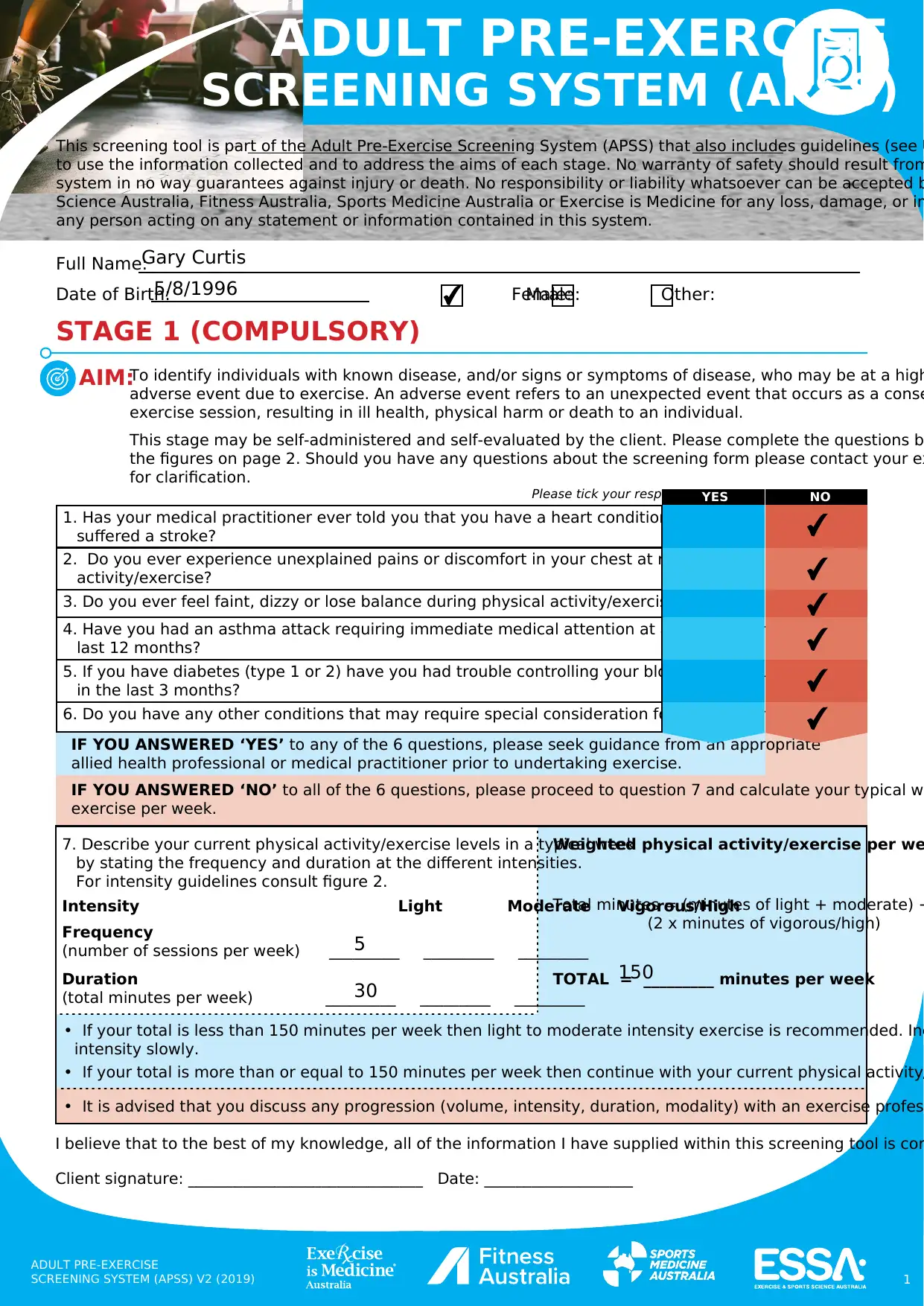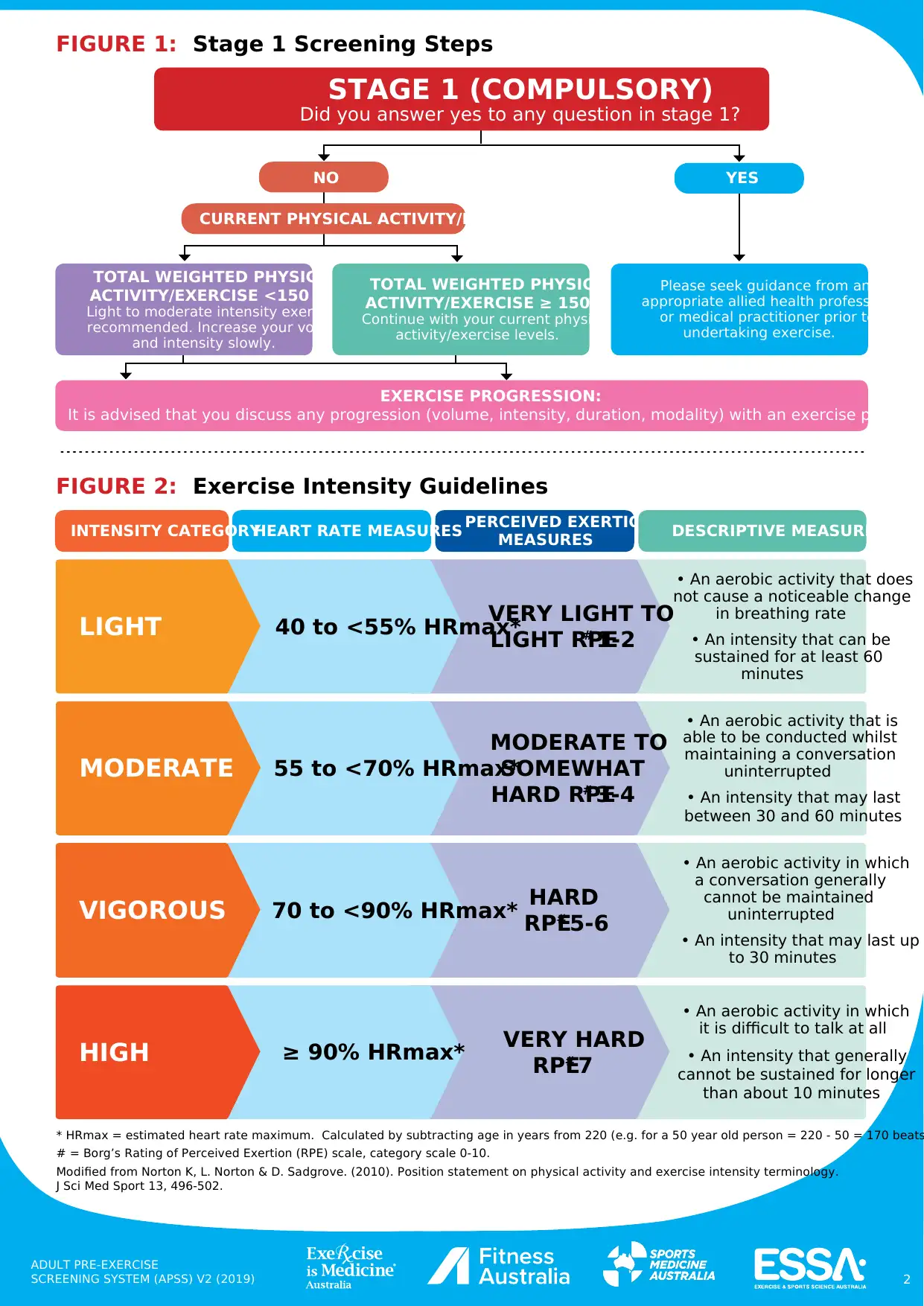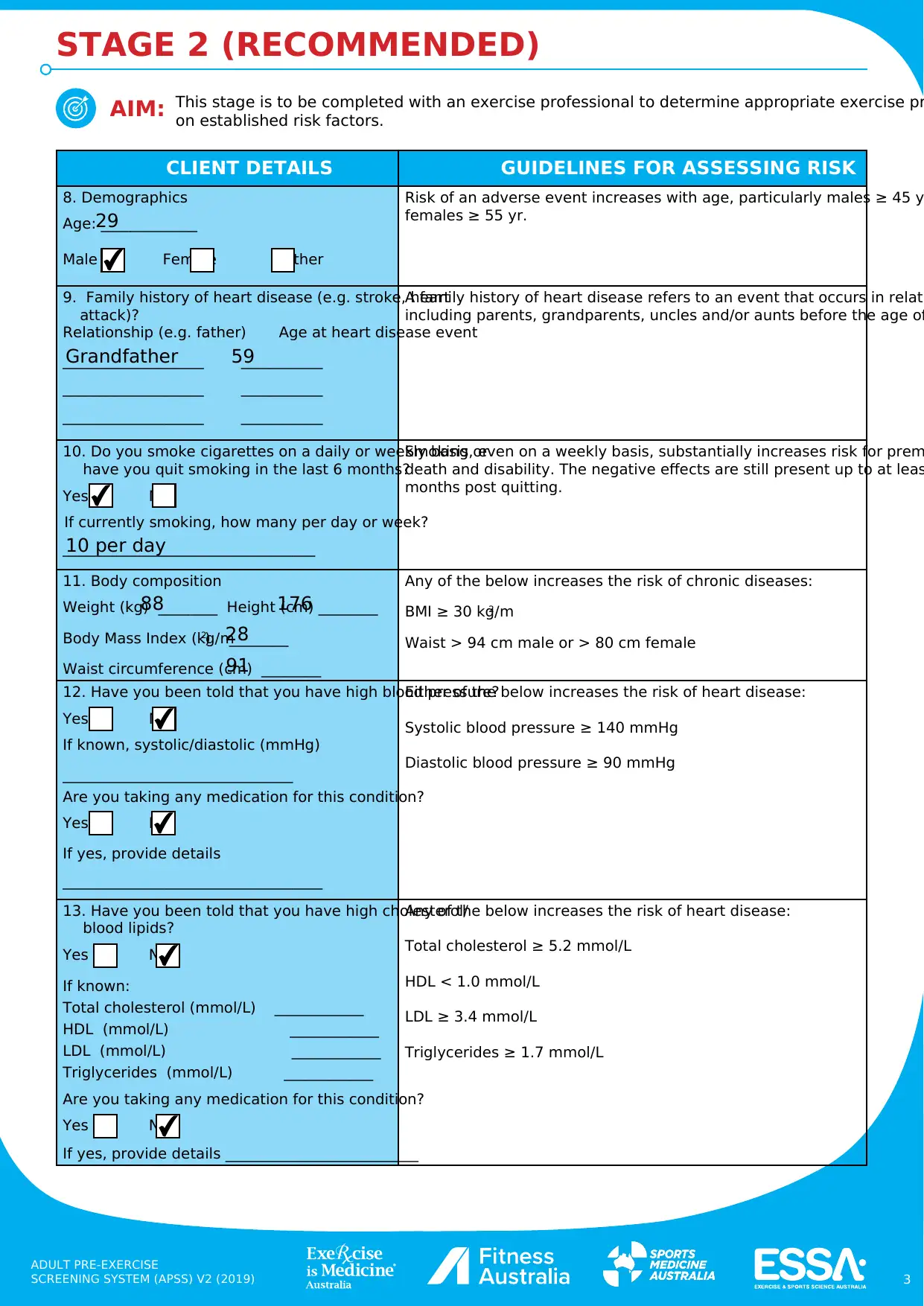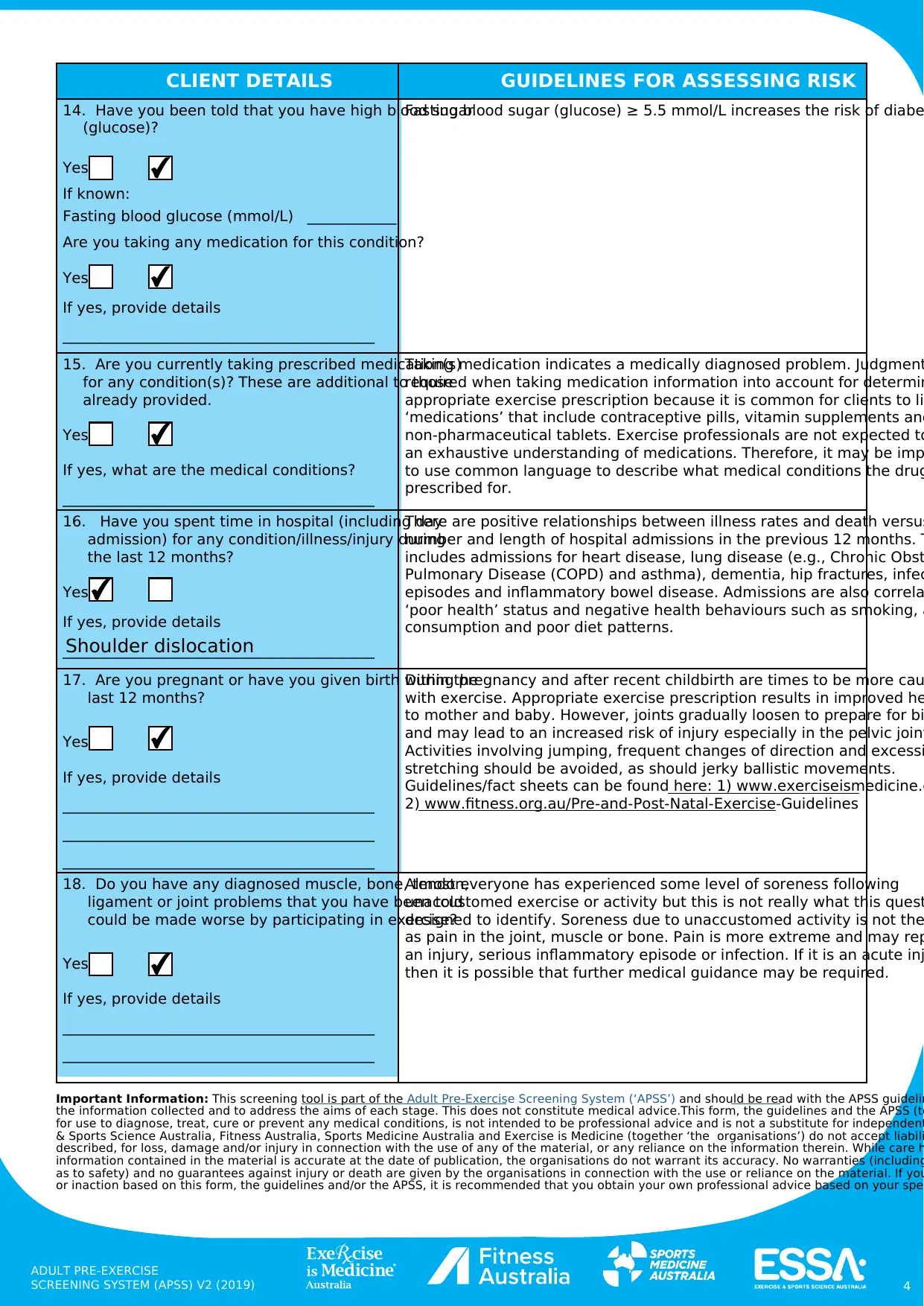Adult Pre- Exercise Information 2022
VerifiedAdded on 2022/10/02
|4
|2247
|22
AI Summary
Contribute Materials
Your contribution can guide someone’s learning journey. Share your
documents today.

1
ADULT PRE-EXERCISE
SCREENING SYSTEM (APSS) V2 (2018)
7. Describe your current physical activity/exercise levels in a typical week
by stating the frequency and duration at the different intensities.
For intensity guidelines consult figure 2.
Intensity Light Moderate Vigorous/High
Frequency
(number of sessions per week) _________ _________ _________
Duration
(total minutes per week) _________ _________ _________
Weighted physical activity/exercise per we
Total minutes = (minutes of light + moderate) +
(2 x minutes of vigorous/high)
TOTAL = _________ minutes per week
I believe that to the best of my knowledge, all of the information I have supplied within this screening tool is cor
• If your total is less than 150 minutes per week then light to moderate intensity exercise is recommended. Inc
intensity slowly.
• If your total is more than or equal to 150 minutes per week then continue with your current physical activity/
• It is advised that you discuss any progression (volume, intensity, duration, modality) with an exercise profes
1
ADULT PRE-EXERCISE
SCREENING SYSTEM (APSS)
This screening tool is part of the Adult Pre-Exercise Screening System (APSS) that also includes guidelines (see U
to use the information collected and to address the aims of each stage. No warranty of safety should result from
system in no way guarantees against injury or death. No responsibility or liability whatsoever can be accepted b
Science Australia, Fitness Australia, Sports Medicine Australia or Exercise is Medicine for any loss, damage, or in
any person acting on any statement or information contained in this system.
Full Name:
Date of Birth: Male:Female: Other:
To identify individuals with known disease, and/or signs or symptoms of disease, who may be at a high
adverse event due to exercise. An adverse event refers to an unexpected event that occurs as a conse
exercise session, resulting in ill health, physical harm or death to an individual.
This stage may be self-administered and self-evaluated by the client. Please complete the questions b
the figures on page 2. Should you have any questions about the screening form please contact your ex
for clarification.
STAGE 1 (COMPULSORY)
AIM:
1. Has your medical practitioner ever told you that you have a heart condition or have you ever
suffered a stroke?
2. Do you ever experience unexplained pains or discomfort in your chest at rest or during physical
activity/exercise?
3. Do you ever feel faint, dizzy or lose balance during physical activity/exercise?
4. Have you had an asthma attack requiring immediate medical attention at any time over the
last 12 months?
5. If you have diabetes (type 1 or 2) have you had trouble controlling your blood sugar (glucose)
in the last 3 months?
6. Do you have any other conditions that may require special consideration for you to exercise?
IF YOU ANSWERED ‘YES’ to any of the 6 questions, please seek guidance from an appropriate
allied health professional or medical practitioner prior to undertaking exercise.
IF YOU ANSWERED ‘NO’ to all of the 6 questions, please proceed to question 7 and calculate your typical w
exercise per week.
Client signature: ______________________________ Date: ___________________
ADULT PRE-EXERCISE
SCREENING SYSTEM (APSS) V2 (2019)
NOYESPlease tick your response
Gary Curtis
5/8/1996
5
30 150
ADULT PRE-EXERCISE
SCREENING SYSTEM (APSS) V2 (2018)
7. Describe your current physical activity/exercise levels in a typical week
by stating the frequency and duration at the different intensities.
For intensity guidelines consult figure 2.
Intensity Light Moderate Vigorous/High
Frequency
(number of sessions per week) _________ _________ _________
Duration
(total minutes per week) _________ _________ _________
Weighted physical activity/exercise per we
Total minutes = (minutes of light + moderate) +
(2 x minutes of vigorous/high)
TOTAL = _________ minutes per week
I believe that to the best of my knowledge, all of the information I have supplied within this screening tool is cor
• If your total is less than 150 minutes per week then light to moderate intensity exercise is recommended. Inc
intensity slowly.
• If your total is more than or equal to 150 minutes per week then continue with your current physical activity/
• It is advised that you discuss any progression (volume, intensity, duration, modality) with an exercise profes
1
ADULT PRE-EXERCISE
SCREENING SYSTEM (APSS)
This screening tool is part of the Adult Pre-Exercise Screening System (APSS) that also includes guidelines (see U
to use the information collected and to address the aims of each stage. No warranty of safety should result from
system in no way guarantees against injury or death. No responsibility or liability whatsoever can be accepted b
Science Australia, Fitness Australia, Sports Medicine Australia or Exercise is Medicine for any loss, damage, or in
any person acting on any statement or information contained in this system.
Full Name:
Date of Birth: Male:Female: Other:
To identify individuals with known disease, and/or signs or symptoms of disease, who may be at a high
adverse event due to exercise. An adverse event refers to an unexpected event that occurs as a conse
exercise session, resulting in ill health, physical harm or death to an individual.
This stage may be self-administered and self-evaluated by the client. Please complete the questions b
the figures on page 2. Should you have any questions about the screening form please contact your ex
for clarification.
STAGE 1 (COMPULSORY)
AIM:
1. Has your medical practitioner ever told you that you have a heart condition or have you ever
suffered a stroke?
2. Do you ever experience unexplained pains or discomfort in your chest at rest or during physical
activity/exercise?
3. Do you ever feel faint, dizzy or lose balance during physical activity/exercise?
4. Have you had an asthma attack requiring immediate medical attention at any time over the
last 12 months?
5. If you have diabetes (type 1 or 2) have you had trouble controlling your blood sugar (glucose)
in the last 3 months?
6. Do you have any other conditions that may require special consideration for you to exercise?
IF YOU ANSWERED ‘YES’ to any of the 6 questions, please seek guidance from an appropriate
allied health professional or medical practitioner prior to undertaking exercise.
IF YOU ANSWERED ‘NO’ to all of the 6 questions, please proceed to question 7 and calculate your typical w
exercise per week.
Client signature: ______________________________ Date: ___________________
ADULT PRE-EXERCISE
SCREENING SYSTEM (APSS) V2 (2019)
NOYESPlease tick your response
Gary Curtis
5/8/1996
5
30 150
Secure Best Marks with AI Grader
Need help grading? Try our AI Grader for instant feedback on your assignments.

2
ADULT PRE-EXERCISE
SCREENING SYSTEM (APSS) V2 (2019)
NO
CURRENT PHYSICAL ACTIVITY/EXERCISE
YES
EXERCISE PROGRESSION:
It is advised that you discuss any progression (volume, intensity, duration, modality) with an exercise professio
FIGURE 1: Stage 1 Screening Steps
FIGURE 2: Exercise Intensity Guidelines
40 to <55% HRmax*
VERY LIGHT TO
LIGHT RPE# 1-2
• An aerobic activity that does
not cause a noticeable change
in breathing rate
• An intensity that can be
sustained for at least 60
minutes
LIGHT
55 to <70% HRmax*
MODERATE TO
SOMEWHAT
HARD RPE# 3-4
• An aerobic activity that is
able to be conducted whilst
maintaining a conversation
uninterrupted
• An intensity that may last
between 30 and 60 minutes
MODERATE
70 to <90% HRmax* HARD
RPE# 5-6
• An aerobic activity in which
a conversation generally
cannot be maintained
uninterrupted
• An intensity that may last up
to 30 minutes
VIGOROUS
≥ 90% HRmax* VERY HARD
RPE# 7
• An aerobic activity in which
it is difficult to talk at all
• An intensity that generally
cannot be sustained for longer
than about 10 minutes
HIGH
* HRmax = estimated heart rate maximum. Calculated by subtracting age in years from 220 (e.g. for a 50 year old person = 220 - 50 = 170 beats
# = Borg’s Rating of Perceived Exertion (RPE) scale, category scale 0-10.
Modified from Norton K, L. Norton & D. Sadgrove. (2010). Position statement on physical activity and exercise intensity terminology.
J Sci Med Sport 13, 496-502.
Did you answer yes to any question in stage 1?
STAGE 1 (COMPULSORY)
INTENSITY CATEGORYHEART RATE MEASURES PERCEIVED EXERTION
MEASURES DESCRIPTIVE MEASURES
TOTAL WEIGHTED PHYSICAL
ACTIVITY/EXERCISE <150 MIN
Light to moderate intensity exercise is
recommended. Increase your volume
and intensity slowly.
TOTAL WEIGHTED PHYSICAL
ACTIVITY/EXERCISE ≥ 150 MIN
Continue with your current physical
activity/exercise levels.
Please seek guidance from an
appropriate allied health professional
or medical practitioner prior to
undertaking exercise.
ADULT PRE-EXERCISE
SCREENING SYSTEM (APSS) V2 (2019)
NO
CURRENT PHYSICAL ACTIVITY/EXERCISE
YES
EXERCISE PROGRESSION:
It is advised that you discuss any progression (volume, intensity, duration, modality) with an exercise professio
FIGURE 1: Stage 1 Screening Steps
FIGURE 2: Exercise Intensity Guidelines
40 to <55% HRmax*
VERY LIGHT TO
LIGHT RPE# 1-2
• An aerobic activity that does
not cause a noticeable change
in breathing rate
• An intensity that can be
sustained for at least 60
minutes
LIGHT
55 to <70% HRmax*
MODERATE TO
SOMEWHAT
HARD RPE# 3-4
• An aerobic activity that is
able to be conducted whilst
maintaining a conversation
uninterrupted
• An intensity that may last
between 30 and 60 minutes
MODERATE
70 to <90% HRmax* HARD
RPE# 5-6
• An aerobic activity in which
a conversation generally
cannot be maintained
uninterrupted
• An intensity that may last up
to 30 minutes
VIGOROUS
≥ 90% HRmax* VERY HARD
RPE# 7
• An aerobic activity in which
it is difficult to talk at all
• An intensity that generally
cannot be sustained for longer
than about 10 minutes
HIGH
* HRmax = estimated heart rate maximum. Calculated by subtracting age in years from 220 (e.g. for a 50 year old person = 220 - 50 = 170 beats
# = Borg’s Rating of Perceived Exertion (RPE) scale, category scale 0-10.
Modified from Norton K, L. Norton & D. Sadgrove. (2010). Position statement on physical activity and exercise intensity terminology.
J Sci Med Sport 13, 496-502.
Did you answer yes to any question in stage 1?
STAGE 1 (COMPULSORY)
INTENSITY CATEGORYHEART RATE MEASURES PERCEIVED EXERTION
MEASURES DESCRIPTIVE MEASURES
TOTAL WEIGHTED PHYSICAL
ACTIVITY/EXERCISE <150 MIN
Light to moderate intensity exercise is
recommended. Increase your volume
and intensity slowly.
TOTAL WEIGHTED PHYSICAL
ACTIVITY/EXERCISE ≥ 150 MIN
Continue with your current physical
activity/exercise levels.
Please seek guidance from an
appropriate allied health professional
or medical practitioner prior to
undertaking exercise.

3
ADULT PRE-EXERCISE
SCREENING SYSTEM (APSS) V2 (2019)
CLIENT DETAILS GUIDELINES FOR ASSESSING RISK
8. Demographics
Age: _____________
Male Female Other
Risk of an adverse event increases with age, particularly males ≥ 45 y
females ≥ 55 yr.
9. Family history of heart disease (e.g. stroke, heart
attack)?
Relationship (e.g. father) Age at heart disease event
___________________ ___________
___________________ ___________
___________________ ___________
A family history of heart disease refers to an event that occurs in relati
including parents, grandparents, uncles and/or aunts before the age of
10. Do you smoke cigarettes on a daily or weekly basis or
have you quit smoking in the last 6 months?
Yes No
If currently smoking, how many per day or week?
__________________________________
Smoking, even on a weekly basis, substantially increases risk for prem
death and disability. The negative effects are still present up to at leas
months post quitting.
11. Body composition
Weight (kg) ________ Height (cm) ________
Body Mass Index (kg/m2
) ________
Waist circumference (cm) ________
Any of the below increases the risk of chronic diseases:
BMI ≥ 30 kg/m2
Waist > 94 cm male or > 80 cm female
12. Have you been told that you have high blood pressure?
Yes No
If known, systolic/diastolic (mmHg)
_______________________________
Are you taking any medication for this condition?
Yes No
If yes, provide details
___________________________________
Either of the below increases the risk of heart disease:
Systolic blood pressure ≥ 140 mmHg
Diastolic blood pressure ≥ 90 mmHg
13. Have you been told that you have high cholesterol/
blood lipids?
Yes No
If known:
Total cholesterol (mmol/L) ____________
HDL (mmol/L) ____________
LDL (mmol/L) ____________
Triglycerides (mmol/L) ____________
Are you taking any medication for this condition?
Yes No
If yes, provide details __________________________
Any of the below increases the risk of heart disease:
Total cholesterol ≥ 5.2 mmol/L
HDL < 1.0 mmol/L
LDL ≥ 3.4 mmol/L
Triglycerides ≥ 1.7 mmol/L
This stage is to be completed with an exercise professional to determine appropriate exercise pr
on established risk factors.
STAGE 2 (RECOMMENDED)
AIM:
29
Grandfather 59
10 per day
88
28
91
176
ADULT PRE-EXERCISE
SCREENING SYSTEM (APSS) V2 (2019)
CLIENT DETAILS GUIDELINES FOR ASSESSING RISK
8. Demographics
Age: _____________
Male Female Other
Risk of an adverse event increases with age, particularly males ≥ 45 y
females ≥ 55 yr.
9. Family history of heart disease (e.g. stroke, heart
attack)?
Relationship (e.g. father) Age at heart disease event
___________________ ___________
___________________ ___________
___________________ ___________
A family history of heart disease refers to an event that occurs in relati
including parents, grandparents, uncles and/or aunts before the age of
10. Do you smoke cigarettes on a daily or weekly basis or
have you quit smoking in the last 6 months?
Yes No
If currently smoking, how many per day or week?
__________________________________
Smoking, even on a weekly basis, substantially increases risk for prem
death and disability. The negative effects are still present up to at leas
months post quitting.
11. Body composition
Weight (kg) ________ Height (cm) ________
Body Mass Index (kg/m2
) ________
Waist circumference (cm) ________
Any of the below increases the risk of chronic diseases:
BMI ≥ 30 kg/m2
Waist > 94 cm male or > 80 cm female
12. Have you been told that you have high blood pressure?
Yes No
If known, systolic/diastolic (mmHg)
_______________________________
Are you taking any medication for this condition?
Yes No
If yes, provide details
___________________________________
Either of the below increases the risk of heart disease:
Systolic blood pressure ≥ 140 mmHg
Diastolic blood pressure ≥ 90 mmHg
13. Have you been told that you have high cholesterol/
blood lipids?
Yes No
If known:
Total cholesterol (mmol/L) ____________
HDL (mmol/L) ____________
LDL (mmol/L) ____________
Triglycerides (mmol/L) ____________
Are you taking any medication for this condition?
Yes No
If yes, provide details __________________________
Any of the below increases the risk of heart disease:
Total cholesterol ≥ 5.2 mmol/L
HDL < 1.0 mmol/L
LDL ≥ 3.4 mmol/L
Triglycerides ≥ 1.7 mmol/L
This stage is to be completed with an exercise professional to determine appropriate exercise pr
on established risk factors.
STAGE 2 (RECOMMENDED)
AIM:
29
Grandfather 59
10 per day
88
28
91
176

4
ADULT PRE-EXERCISE
SCREENING SYSTEM (APSS) V2 (2019)
CLIENT DETAILS GUIDELINES FOR ASSESSING RISK
14. Have you been told that you have high blood sugar
(glucose)?
Yes No
If known:
Fasting blood glucose (mmol/L) ____________
Are you taking any medication for this condition?
Yes No
If yes, provide details
__________________________________________
Fasting blood sugar (glucose) ≥ 5.5 mmol/L increases the risk of diabe
15. Are you currently taking prescribed medication(s)
for any condition(s)? These are additional to those
already provided.
Yes No
If yes, what are the medical conditions?
__________________________________________
Taking medication indicates a medically diagnosed problem. Judgment
required when taking medication information into account for determin
appropriate exercise prescription because it is common for clients to li
‘medications’ that include contraceptive pills, vitamin supplements and
non-pharmaceutical tablets. Exercise professionals are not expected to
an exhaustive understanding of medications. Therefore, it may be imp
to use common language to describe what medical conditions the drug
prescribed for.
16. Have you spent time in hospital (including day
admission) for any condition/illness/injury during
the last 12 months?
Yes No
If yes, provide details
__________________________________________
There are positive relationships between illness rates and death versus
number and length of hospital admissions in the previous 12 months. T
includes admissions for heart disease, lung disease (e.g., Chronic Obst
Pulmonary Disease (COPD) and asthma), dementia, hip fractures, infec
episodes and inflammatory bowel disease. Admissions are also correla
‘poor health’ status and negative health behaviours such as smoking, a
consumption and poor diet patterns.
17. Are you pregnant or have you given birth within the
last 12 months?
Yes No
If yes, provide details
__________________________________________
__________________________________________
__________________________________________
During pregnancy and after recent childbirth are times to be more cau
with exercise. Appropriate exercise prescription results in improved he
to mother and baby. However, joints gradually loosen to prepare for bi
and may lead to an increased risk of injury especially in the pelvic joint
Activities involving jumping, frequent changes of direction and excessi
stretching should be avoided, as should jerky ballistic movements.
Guidelines/fact sheets can be found here: 1) www.exerciseismedicine.c
2) www.fitness.org.au/Pre-and-Post-Natal-Exercise-Guidelines
18. Do you have any diagnosed muscle, bone, tendon,
ligament or joint problems that you have been told
could be made worse by participating in exercise?
Yes No
If yes, provide details
__________________________________________
__________________________________________
Almost everyone has experienced some level of soreness following
unaccustomed exercise or activity but this is not really what this quest
designed to identify. Soreness due to unaccustomed activity is not the
as pain in the joint, muscle or bone. Pain is more extreme and may rep
an injury, serious inflammatory episode or infection. If it is an acute inj
then it is possible that further medical guidance may be required.
Important Information: This screening tool is part of the Adult Pre-Exercise Screening System (‘APSS’) and should be read with the APSS guidelin
the information collected and to address the aims of each stage. This does not constitute medical advice.This form, the guidelines and the APSS (to
for use to diagnose, treat, cure or prevent any medical conditions, is not intended to be professional advice and is not a substitute for independent
& Sports Science Australia, Fitness Australia, Sports Medicine Australia and Exercise is Medicine (together ‘the organisations’) do not accept liabili
described, for loss, damage and/or injury in connection with the use of any of the material, or any reliance on the information therein. While care h
information contained in the material is accurate at the date of publication, the organisations do not warrant its accuracy. No warranties (including
as to safety) and no guarantees against injury or death are given by the organisations in connection with the use or reliance on the material. If you
or inaction based on this form, the guidelines and/or the APSS, it is recommended that you obtain your own professional advice based on your spe
Shoulder dislocation
ADULT PRE-EXERCISE
SCREENING SYSTEM (APSS) V2 (2019)
CLIENT DETAILS GUIDELINES FOR ASSESSING RISK
14. Have you been told that you have high blood sugar
(glucose)?
Yes No
If known:
Fasting blood glucose (mmol/L) ____________
Are you taking any medication for this condition?
Yes No
If yes, provide details
__________________________________________
Fasting blood sugar (glucose) ≥ 5.5 mmol/L increases the risk of diabe
15. Are you currently taking prescribed medication(s)
for any condition(s)? These are additional to those
already provided.
Yes No
If yes, what are the medical conditions?
__________________________________________
Taking medication indicates a medically diagnosed problem. Judgment
required when taking medication information into account for determin
appropriate exercise prescription because it is common for clients to li
‘medications’ that include contraceptive pills, vitamin supplements and
non-pharmaceutical tablets. Exercise professionals are not expected to
an exhaustive understanding of medications. Therefore, it may be imp
to use common language to describe what medical conditions the drug
prescribed for.
16. Have you spent time in hospital (including day
admission) for any condition/illness/injury during
the last 12 months?
Yes No
If yes, provide details
__________________________________________
There are positive relationships between illness rates and death versus
number and length of hospital admissions in the previous 12 months. T
includes admissions for heart disease, lung disease (e.g., Chronic Obst
Pulmonary Disease (COPD) and asthma), dementia, hip fractures, infec
episodes and inflammatory bowel disease. Admissions are also correla
‘poor health’ status and negative health behaviours such as smoking, a
consumption and poor diet patterns.
17. Are you pregnant or have you given birth within the
last 12 months?
Yes No
If yes, provide details
__________________________________________
__________________________________________
__________________________________________
During pregnancy and after recent childbirth are times to be more cau
with exercise. Appropriate exercise prescription results in improved he
to mother and baby. However, joints gradually loosen to prepare for bi
and may lead to an increased risk of injury especially in the pelvic joint
Activities involving jumping, frequent changes of direction and excessi
stretching should be avoided, as should jerky ballistic movements.
Guidelines/fact sheets can be found here: 1) www.exerciseismedicine.c
2) www.fitness.org.au/Pre-and-Post-Natal-Exercise-Guidelines
18. Do you have any diagnosed muscle, bone, tendon,
ligament or joint problems that you have been told
could be made worse by participating in exercise?
Yes No
If yes, provide details
__________________________________________
__________________________________________
Almost everyone has experienced some level of soreness following
unaccustomed exercise or activity but this is not really what this quest
designed to identify. Soreness due to unaccustomed activity is not the
as pain in the joint, muscle or bone. Pain is more extreme and may rep
an injury, serious inflammatory episode or infection. If it is an acute inj
then it is possible that further medical guidance may be required.
Important Information: This screening tool is part of the Adult Pre-Exercise Screening System (‘APSS’) and should be read with the APSS guidelin
the information collected and to address the aims of each stage. This does not constitute medical advice.This form, the guidelines and the APSS (to
for use to diagnose, treat, cure or prevent any medical conditions, is not intended to be professional advice and is not a substitute for independent
& Sports Science Australia, Fitness Australia, Sports Medicine Australia and Exercise is Medicine (together ‘the organisations’) do not accept liabili
described, for loss, damage and/or injury in connection with the use of any of the material, or any reliance on the information therein. While care h
information contained in the material is accurate at the date of publication, the organisations do not warrant its accuracy. No warranties (including
as to safety) and no guarantees against injury or death are given by the organisations in connection with the use or reliance on the material. If you
or inaction based on this form, the guidelines and/or the APSS, it is recommended that you obtain your own professional advice based on your spe
Shoulder dislocation
1 out of 4
Related Documents
Your All-in-One AI-Powered Toolkit for Academic Success.
+13062052269
info@desklib.com
Available 24*7 on WhatsApp / Email
![[object Object]](/_next/static/media/star-bottom.7253800d.svg)
Unlock your academic potential
© 2024 | Zucol Services PVT LTD | All rights reserved.





